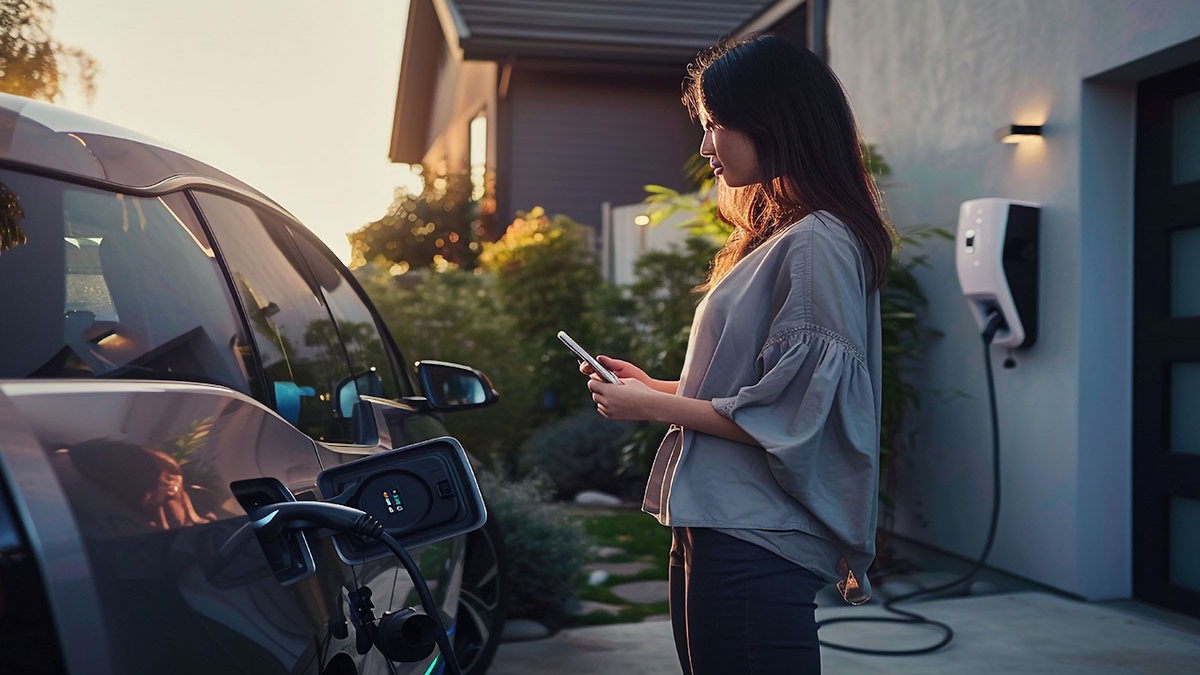 충전하는 동안 전기 자동차를 사용할 수 있나요?
충전하는 동안 전기 자동차를 사용할 수 있나요?
Nov 06, 2025
EV 운전자들 사이에서 흔히 묻는 질문최근 전기 자동차(EV)로 바꾸셨다면 다음과 같은 의문이 드셨을 것입니다. 충전하는 동안에도 차를 사용할 수 있나요?많은 전기차 소유자들은 전기차를 충전한 채로 에어컨을 켜거나, 음악을 듣거나, 차량 내부에 앉아 있는 것이 안전한지 궁금해합니다. 심지어 충전 중에도 차량을 운전할 수 있는지 궁금해하는 사람들도 있습니다. 짧은 대답은 다음과 같습니다. 예, 당신은 일반적으로 할 수 있습니다 충전하는 동안 EV 시스템을 켜세요 - 하지만 no, 당신은 할 수 없습니다 운전하다.그 이유가 무엇인지, 충전하는 동안 무슨 일이 일어나는지, 그리고 안전하게 충전하는 방법을 알아보겠습니다. EV 충전 시 발생하는 일EV가 플러그인되면 배터리 관리 시스템(BMS)제어권을 갖습니다. 전압, 전류, 온도를 조절하여 충전기에서 배터리 팩으로 에너지가 안전하게 흐르도록 합니다. 동시에 대부분의 전기 자동차는 자동으로 드라이브 시스템 잠금충전이 멈출 때까지 차량이 움직이지 않도록 합니다.주요 충전 레벨은 세 가지입니다.레벨 1(일반 가정용 콘센트) – 느리게, 밤새 충전.레벨 2(전용 AC 충전기) – 더 빠르고, 가정이나 직장에서 사용하기에 적합합니다.DC 고속 충전 – 매우 강력한 전력으로 공공 방송국에서 찾을 수 있습니다. 각 레벨에는 충전기와 차량 간의 통신 기능이 내장되어 있어 전력을 안전하게 관리할 수 있습니다. 충전하는 동안 할 수 있는 일과 할 수 없는 일"자동차를 사용한다"는 말은 여러 가지 의미를 가질 수 있습니다. 직접 운전할 수는 없지만, 자동차에 플러그를 꽂아 두면 여러 시스템을 사용할 수 있습니다.✅ 안전하게 다음을 수행할 수 있습니다.켜다 인포테인먼트 시스템음악을 듣거나 설정을 확인합니다.사용 기후 조절실내를 예열 또는 냉각하는 기능(일반적인 EV 기능).켜다 실내등또는 USB 포트를 통해 소형 기기를 충전하세요.대시보드나 모바일 앱에서 충전 진행 상황을 모니터링하세요. 다음 작업은 수행할 수 없습니다.주행 또는 후진으로 전환합니다.차량을 옮기세요(대부분의 차량은 주차 위치에 잠겨 있습니다).모터 또는 회생 제동 시스템을 작동시킵니다. 최신 전기차가 이렇게 설계된 데에는 이유가 있습니다. 충전 중에 시동을 걸면 차량은 안전한 충전 전류를 유지하면서 제한된 시스템에 전력망 전력이나 배터리 전력을 사용합니다. 충전하는 동안 자동차 전원을 켜두는 것이 안전한가요?일반적으로 그렇습니다. 사용하는 동안에는 그렇습니다. 인증된 장비그리고 좋은 품질의 케이블.케이블, 커넥터 또는 충전기가 기준에 미달하거나 손상된 경우 일반적으로 안전 위험이 발생합니다.잠재적 위험은 다음과 같습니다.과열케이블 절연이 불량하기 때문입니다.전류 서지고전력 시스템(예: 히터)을 동시에 사용하는 경우.충전 효율 감소에너지가 액세서리를 작동시키는 데 소모되는 경우. 가정용 vs. 공공 충전 시나리오충전 환경도 자동차가 플러그에 연결되어 있는 동안 할 수 있는 일에 영향을 미칩니다. 집에서전력 수준은 일반적으로 낮습니다(16~32A). 따라서 에어컨이나 좌석 난방과 같은 시스템을 켠 채로 차량 안에 앉아 있어도 안전합니다.전류가 일정하기 때문에 사소한 액세서리를 사용해도 충전 시간에 눈에 띄는 영향이 없습니다.A 벽걸이형 충전기, 예를 들어 호환되는 것과 같은 Workersbee의 레벨 2 충전 케이블, 내장된 안전 기능으로 밤새 안정적으로 충전할 수 있습니다. 공공 고속 충전기에서전력 출력은 훨씬 더 높습니다(최대 350kW).일부 차량은 안전을 위해 대부분의 차량 내 시스템을 자동으로 비활성화합니다.차량 내부에 오랫동안 머물거나 부하가 큰 기능을 사용하지 않는 것이 좋습니다. 적절하게 인증된 공공 충전기와 케이블을 사용하면 두 환경 모두에서 안전하게 작동할 수 있습니다. 운전하면서 동시에 충전할 수 있나요?이 질문은 종종 제기되며 그 답은 다음과 같습니다. no, 적어도 아직은 그렇지 않아요.물리적으로, 고정된 전원에 연결된 자동차는 안전하게 움직일 수 없습니다. 커넥터는 제자리에 고정되도록 설계되었으며, 플러그를 뽑으면 즉시 전원이 차단됩니다. 그러나 새로운 기술로 알려진 동적 무선 충전(또는 이동 중 충전)은 유럽과 아시아 일부 지역에서 시험 중입니다. 이 시스템은 도로 표면 아래에 내장된 코일을 사용하여 주행 중 차량에 무선으로 에너지를 전달합니다. 안전하고 효율적인 충전을 위한 모범 사례자동차와 충전기를 최상의 상태로 유지하려면 다음의 간단한 모범 사례를 따르세요.인증된 케이블과 커넥터를 사용하세요 — CE, UL 또는 TUV 마크를 찾아보세요.불필요한 시스템 실행을 피하세요(고온 시트 워머처럼) 충전하는 동안.케이블과 플러그 온도를 확인하세요가끔.통풍이 잘 되도록 하세요특히 밀폐된 차고의 경우.제조업체의 충전 가이드를 따르세요배터리 상태를 유지하려면. 자주 묻는 질문전기차를 충전하는 동안 에어컨이나 히터를 사용할 수 있나요?네. 대부분의 전기차는 플러그를 꽂은 상태에서도 사전 조절이 가능하며, 배터리가 아닌 전력망에서 직접 전력을 공급받습니다. 자동차를 사용하면 충전 속도가 느려지나요?약간 - 주요 시스템을 사용하면 소량의 에너지를 전환할 수 있지만, 레벨 2 이상 충전기를 사용하면 무시할 수 있습니다. 충전하는 동안 차 안에 앉아 있어도 안전한가요?네, 인증된 장비를 사용하고 환기가 잘 되는 곳에서는 가능합니다. 충전하면서 운전할 수 있나요?아니요. 충전이 시작되면 안전을 위해 구동 시스템이 잠깁니다. 적절한 장비를 사용하면 안전하게 사용할 수 있습니다.그렇다면 충전하는 동안 전기 자동차를 사용할 수 있나요?물론입니다. 단, 한계를 이해해야 합니다. 에어컨이나 인포테인먼트 시스템 같은 차량 내 시스템은 안전하게 작동할 수 있지만, 충전 중에는 절대 차량을 운전하거나 움직이지 마십시오. 안전은 항상 장비 품질에 달려 있습니다. 인증된 고급 커넥터 및 충전기, 에 의해 디자인된 것과 같은 워커스비최적의 성능과 마음의 평화를 보장합니다. 스마트하고 안전한 충전에 대해 자세히 알아보세요안전한 충전은 올바른 기술부터 시작됩니다.더 자세히 알고 싶으시다면 안정적인 EV 충전 솔루션, 탐구하다 Workersbee의 인증 충전기, 케이블 및 커넥터 제품군 — 국제 안전 기준을 충족하도록 설계되었으며 가정과 상업용 충전 요구 사항을 모두 지원합니다. 품질과 안전에 기반한 혁신을 통해 워커스비모든 EV 운전자에게 도움이 됩니다 더욱 스마트하고, 안전하고, 빠르게 충전하세요.
더 읽어보기

 충전하는 동안 전기 자동차를 사용할 수 있나요?
충전하는 동안 전기 자동차를 사용할 수 있나요?